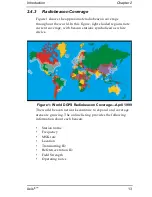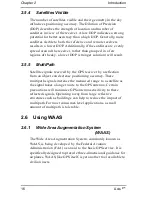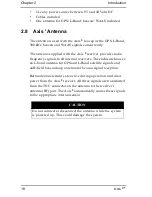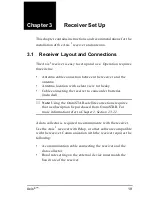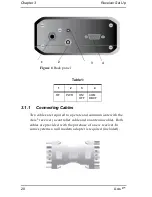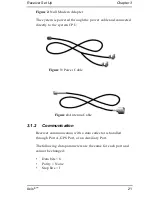
6
Axis
3™
Chapter 2
Introduction
To calculate a geographic position, the GPS receiver uses a
complex algorithm incorporating satellite coordinates and
ranges to each satellite. Reception of any four or more of these
signals allows a GPS receiver to compute 3D coordinates.
Tracking of only three satellites reduces the position fix to 2D
coordinates (horizontal with fixed vertical).
2.1.2
GPS Services
The positioning accuracy offered by GPS varies depending
upon the type of service and equipment available. For security
reasons, two GPS services exist: the Standard Positioning
Service (SPS) and the Precise Positioning Service (PPS). The US
DoD reserves the PPS for use by its personnel and authorized
partners. The DoD provides the SPS free of charge, worldwide,
to all civilian users.
For many positioning and navigation applications, stand-alone
or autonomous accuracy is insufficient, and differential
positioning techniques must be employed.
2.1.3
DGPS Format, GPS Standard
For manufacturers of GPS equipment, commonality is essential
to maximize the utility and compatibility of a product. The
governing standard associated with GPS is the Interface
Control Document, ICD-GPS-200, maintained by the US DoD.
This document provides the message and signal structure
information required to access GPS.
Like GPS, DGPS data and broadcast standards exist to ensure
compatibility between DGPS networks and associated
hardware and software. The Radio Technical Commission for
Maritime Services Special Committee 104 has developed the
primary DGPS standard associated with radiobeacon DGPS,
designated RTCM SC-104 V2.2.
Summary of Contents for Axis 3
Page 1: ... Axis 3 TM Operations Manual Part Number 750 1 0060 Rev 2 GPS Receiver System ...
Page 6: ......
Page 10: ......
Page 11: ...Welcome Chapter 1 Axis 3 5 ...
Page 33: ......
Page 41: ......
Page 43: ......
Page 48: ......
Page 51: ...43 Axis 3 Appendix C Frequently Asked Questions ...
Page 53: ......




















